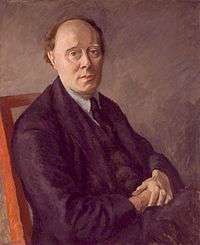Clive Bell
Arthur Clive Heward Bell (16 September 1881 – 17 September 1964)[1] was an English art critic, associated with formalism and the Bloomsbury Group. He developed the art theory known as significant form.

Biography
Origins
Bell was born in East Shefford, Berkshire, in 1881, the third of four children of William Heward Bell (1849–1927) and Hannah Taylor Cory (1850–1942). He had an elder brother (Cory), an elder sister (Lorna, Mrs Acton), and a younger sister (Dorothy, Mrs Hony). His father was a civil engineer who built his fortune in the family coal mines in Wiltshire in England and Merthyr Tydfil in Wales – "a family which drew its wealth from Welsh mines and expended it on the destruction of wild animals."[2] They lived at Cleeve House, Seend, near Devizes, Wiltshire, where Squire Bell's many hunting trophies were displayed.
Marriage and other liaisons
Bell was educated at Marlborough College and at Trinity College, Cambridge,[3] studying history. In 1902 he gained an Earl of Derby scholarship to study in Paris, where his interest in art began. On returning to London early in 1907 he met and married Vanessa Stephen, the artist sister of Virginia Woolf.[4][5][6] They had two sons, Julian and Quentin, who both became writers. Julian joined the Republican side in the Spanish Civil War as an ambulance driver and was killed in 1937 by an enemy shell, aged 29.[7]
By World War I their marriage was over. Vanessa had begun a lifelong relationship with Duncan Grant, and Clive had a number of liaisons with other women including Mary Hutchinson. However, Clive and Vanessa never officially separated or divorced. Not only did they visit each other regularly, they also sometimes spent holidays together and paid "family" visits to Clive's parents. Clive lived in London but often spent long periods at a farmhouse in Charleston, Sussex, where Vanessa lived with Duncan and her three children by Clive and Duncan. He supported her wish to have a child by Duncan and allowed his wife's only daughter, Angelica, to bear his surname.
Vanessa's daughter by Duncan, Angelica Garnett (née Bell), was raised as Clive's daughter until she married. She was informed, by her mother Vanessa, just prior to her marriage and shortly after her brother Julian's death, that Duncan Grant was her biological father.[8]
According to historian Stanley Rosenbaum, "Bell may, indeed, be the least liked member of Bloomsbury.... Bell has been found wanting by biographers and critics of the Group – as a husband, a father, and especially a brother-in-law. It is undeniable that he was a wealthy snob, hedonist, and womaniser, a racist and an anti-Semite (but not a homophobe), who changed from a liberal socialist and pacifist into a reactionary appeaser. Bell's reputation has led to his being underestimated in the history of Bloomsbury...."[9]
Significant form
Soon after Bell met Roger Fry, he developed his art theory significant form. The two shared a passion for contemporary French art. Bell's book Art (1914) was the first publication of his theory, which he describes as "lines and colours combined in a particular way, certain forms, and relations of forms, that stir our aesthetic emotions."[10] This form can be seen in art created by many members of the Bloomsbury Group, an example being Interior at Gordon Square by Duncan Grant.
Political views
Bell was at one point an adherent of absolute pacifism, and during the First World War was a conscientious objector, allowed to perform Work of National Importance by assisting on the farm of Philip Morrell MP, at Garsington Manor. In his 1938 pamphlet War Mongers, he opposed any attempt by Britain to use military force, arguing "the worst tyranny is better than the best war."[11][12] However, by 1940 Bell was a supporter of the British war effort, calling for a "ceaseless war against Hitler".[12]
Works
- Art (1914)
- Pot-boilers (1918)
- Since Cézanne (1922)
- Civilization (1928)
- Proust (1929)
- An Account of French Painting (1931)
- Old Friends (1956)
References
- Bell, Arthur Clive Heward - Oxford Reference. 2006. doi:10.1093/acref/9780199754694.001.0001. ISBN 9780199754694. Retrieved 17 September 2018.
- Bell, Quentin Bloomsbury, London: Futura, 1974, p. 19.
- "Bell [post Clive-Bell], Arthur Clive Heward (BL899AC)". A Cambridge Alumni Database. University of Cambridge.
- Virginia Woolf biography and visits Info Britain, accessed 2 October 2014.
- "Index entry: Bell Arthur Clive H." Transcription of English and Welsh marriage registrations 1837–1983. ONS. Retrieved 24 May 2016.
- "Index entry: Stephen Vanessa". Transcription of English and Welsh marriage registrations 1837–1983. ONS. Retrieved 24 May 2016.
- Lee, Hermione Virginia Woolf, London: Vintage, 1997, p. 697.
- Lee, Hermione Virginia Woolf, London: Vintage 1997 p. 698. This deception forms the central message of her memoir, Deceived with Kindness (1984).
- S.P. Rosenbaum (2003). Georgian Bloomsbury: Volume 3: The Early Literary History of the Bloomsbury Group, 1910–1914. Palgrave Macmillan UK. p. 37. ISBN 978-0-230-50512-4.
- Bell, Clive (1916). Art. Chatto & Windus. p. 8.
- Susan Sellers, The Cambridge Companion to Virginia Woolf Cambridge University Press, 2010; ISBN 0521896940, (p. 23).
- Lawrence James, Warrior Race: A History of the British at War, Hachette UK, 2010; ISBN 0748125353 (p. 620).
Sources
- Bell, Clive (2015) [1914]. Art. CreateSpace Independent Publishing Platform. ISBN 9781514244715.
- Bywater, William G (1975). Clive Bell's Eye. Detroit: Wayne State University Press. ISBN 9780814315347.